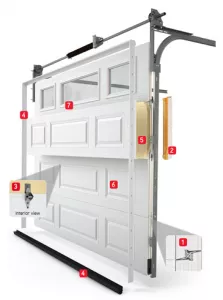
Garage doors have electric openers, which use energy. However, that is not the only way they can impact your utility bill. From the outside, most doors look the same, but each has an R-value or RSI. Though two doors may have equal R-values, the way the doors are made can make one far more efficient. There are also issues with top‑performing weatherseals and thermal breaks.
So, if you are considering a new door, you need to know the following details to get an efficient door for your home:
Go with wooden end blocks
We have come to think of wood as low-tech, and therefore we don’t see it as a quality material in a garage door. However, in any high quality garage door, there will always be Section end blocks used to keep the insulating materials in place.
They also secure hinges at either side of the door, and over them and to seal the individual sections, manufacturers add weatherstripping and a glue joint that links the exterior metal sheeting to the interior panels.
Typically, North American garage door manufacturers use a process of cutting steel sheeting about 26″ wide (66 cm) to the length needed for the particular door. They will then use steel end caps to seal and finish the panels. As you might imagine, this metal to metal contact, with nothing else creating a barrier allows for thermal bridging; during which time the metal can transfer heat from indoors to outdoors and vice versa.
Garaga avoids this by using a unique injection and manufacturing approach. In it, sections are individually manufactured, and wood end blocks are used. This is because wood is less likely to transfer heat. Each section is closed before insulation is placed, further preventing the creation of a thermal break.
Joining door sections
Of course, you can still experience the transfer of heat if you join the two exterior sheets of steel covering insulation with a less effective method. One typical approach is the use of a metal staple with or without glue, which is not the most efficient method.
Garaga uses a triple-contact PVC weatherseal to connect the two sheets, preventing the heat thermal bridge from forming by blocking any connections between exterior metal sheeting and interior metal panels.
Weatherstripping and the exterior of the door
The quality of the weatherstripping placed along the exterior and lower edge of the garage door can also play a role in energy efficiency, or inefficiency. Many manufacturers utilize low grade PVC weatherstripping, which can harden and lose any protective qualities when exposed to deep freezes.
Garage relies strictly on premium PVC weatherstripping with a double-lipped design and arctic grade performance, remaining flexible even down to -15°F (-25°C).
Weatherstripping and the bottom of the door
As we said, the weatherstripping can be exposed to intense conditions, and if it fails in freezing weather, it allows heat to escape. This is true along the entire perimeter, including the bottom of the garage door. Garaga avoids this by using a TPE (Thermal Plastic Elastomer)-based weatherseal with the ability to remain flexible down to -52°F (-62°C) conditions.
Use what you know
Any garage door’s energy efficiency is due to several factors, including components and its construction. R‑value or RSI is important, but it isn’t the only factor. You need to know about manufacturing, weatherstripping, end sections, and more.
If you still have questions about the ways your garage door might be costing you precious energy fees, just contact us toll-free anytime at 860-666-9315. We are some of the most knowledgeable and experienced advisors and can explain the best choice in garage door for you, and always based on your specific needs as well as your budget. We can send over a quotation by email. However, we’re always happy to meet customers in person in our showroom. There you can try out our innovative Design Centre to see what style best suits your home, or you can use our image gallery to get inspiration and ideas from others.








Add new comment